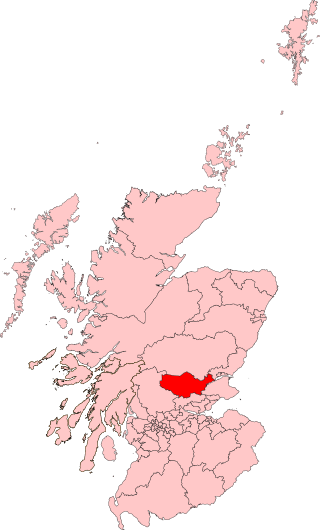Related Research Articles
Edinburghshire was a Scottish county constituency of the House of Commons of the Parliament of Great Britain from 1708 to 1801 and of the Parliament of the United Kingdom from 1801 to 1918.
Ross and Cromarty was a county constituency of the House of Commons of the UK Parliament from 1832 to 1983. It elected one Member of Parliament (MP) using the first-past-the-post voting system.

Dumfriesshire was a county constituency represented in the House of Commons of Great Britain from 1708 to 1801 and in the House of Commons of the Parliament of the United Kingdom from 1801 until 2005. It was known as Dumfries from 1950.
Leith was a burgh constituency of the House of Commons of the Parliament of the United Kingdom from 1918 to 1950. The constituency elected one Member of Parliament (MP) by the first past the post system of election.
Forfarshire was a Scottish county constituency represented in the House of Commons of Great Britain from 1708 until 1800, and then in the House of Commons of the United Kingdom until 1950.
Bothwell was a county constituency in Lanarkshire represented in the House of Commons of the Parliament of the United Kingdom from 1918 to 1983. It was formed by the division of Lanarkshire constituency.
Coatbridge was a parliamentary constituency represented in the House of Commons of the Parliament of the United Kingdom. It returned one Member of Parliament (MP) from 1918 to 1950, elected by the first past the post voting system.

West Renfrewshire was a county constituency of the House of Commons of the Parliament of the United Kingdom from 1885 to 1983 and again from 1997 until 2005. In 2005 the constituency was abolished and the area is now represented by Inverclyde, Paisley and Renfrewshire North and Paisley and Renfrewshire South.
Dunbartonshire was a county constituency of the House of Commons of Great Britain from 1708 to 1801 and of the House of Commons of the Parliament of the United Kingdom from 1801 to 1950.

Perth was a constituency of the House of Commons of the Parliament of the United Kingdom from 1832 to 1918, 1918 to 1950, and 1997 to 2005. From 1832 to 1918 it was a burgh constituency. From 1918 to 1950, and 1997 to 2005, it was a county constituency. During each of the three periods it elected one Member of Parliament (MP).
Bute and Northern Ayrshire was a county constituency of the House of Commons of the Parliament of the United Kingdom from 1918 to 1983. It elected one Member of Parliament (MP) by the first past the post voting system.
Dumbarton Burghs was a district of burghs constituency of the House of Commons of the Parliament of the United Kingdom from 1918 to 1950.
West Stirlingshire was a county constituency of the House of Commons of the Parliament of the United Kingdom, to which it elected one Member of Parliament (MP) by the first past the post electoral system.
Inverness was a county constituency of the House of Commons of the Parliament of the United Kingdom from 1918 until 1983. It elected one Member of Parliament (MP) by the first-past-the-post system of election.
Dunfermline Burghs was a burgh constituency of the House of Commons of the Parliament of the United Kingdom from 1918 until 1974. It elected one Member of Parliament (MP) using the first-past-the-post voting system.
Kilmarnock was a county constituency of the House of Commons of the Parliament of the United Kingdom from 1918 to 1983. It elected one Member of Parliament (MP) by the first past the post system of election.
Roxburgh and Selkirk was a county constituency of the House of Commons of the Parliament of the United Kingdom (Westminster) from 1918 to 1955. It elected one Member of Parliament (MP) by the first past the post voting system.
Peebles and Southern Midlothian was a county constituency of the House of Commons of the Parliament of the United Kingdom (Westminster) from 1918 to 1950. It elected one Member of Parliament (MP) by the first past the post voting system.
The 1929 Midlothian and Peebles Northern by-election was a parliamentary by-election held in Scotland on 29 January 1929 to elect a new Member of Parliament (MP) for the UK House of Commons constituency of Midlothian and Peebles Northern.
The 1943 Midlothian and Peebles Northern by-election was a parliamentary by-election held in Scotland on 11 February 1943 to elect a new Member of Parliament (MP) for the UK House of Commons constituency of Midlothian and Peebles Northern.
References
- ↑ Leigh Rayment's Historical List of MPs – Constituencies beginning with "M" (part 2)
- ↑ Whitaker's Almanack, 1920
- 1 2 3 4 Craig, F.W.S., ed. (1969). British parliamentary election results 1918-1949 . Glasgow: Political Reference Publications. p. 638. ISBN 0-900178-01-9.
- ↑ Debrett's House of Commons and the Judicial Bench, 1922
- ↑ The Times, 17 November 1922
- ↑ The Constitutional Year Book 1929
- ↑ The Liberal Year Book 1929
- ↑ Oliver & Boyd's Edinburgh Almanac, 1927
- ↑ The Times, 31 January 1929
- ↑ The Times, 1 June 1929
- ↑ Whitaker's Almanack, 1934
- ↑ Whitaker's Almanack, 1939
- ↑ Whitaker's Almanack, 1944
- ↑ Craig, F. W. S. (1983) [1969]. British parliamentary election results 1918–1949 (3rd ed.). Chichester: Parliamentary Research Services. p. 638. ISBN 0-900178-06-X.